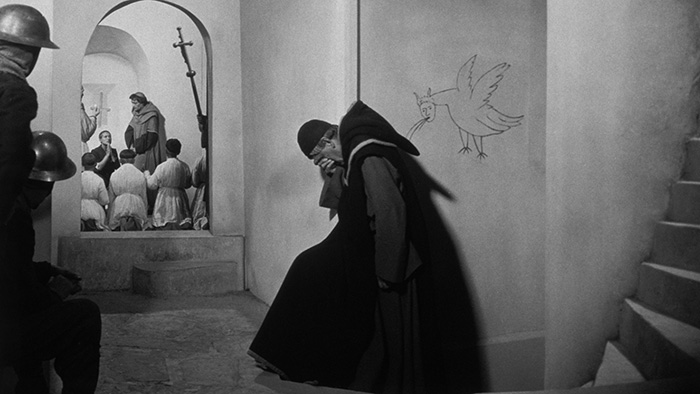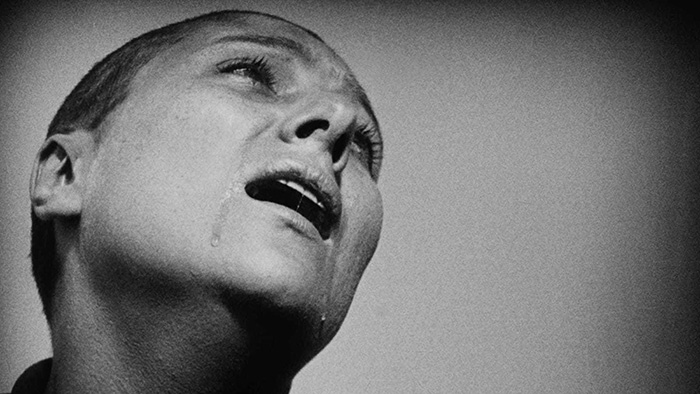His ways are not our ways.
The history of Carl Theodor Dreyer‘s masterwork La passion de Jeanne d’Arc [The Passion of Joan of Arc] is almost too perfectly attuned to the subject matter itself. Here was a renowned director hired to craft a movie about France’s most famous Catholic despite being neither French nor Catholic. Dreyer became a sort of pariah, helpless as the Archbishop of Paris and government officials demanded edits out of his control. His original cut then burned in a studio fire before a second created with alternate takes (it’s said Dreyer took many to ensure he received the correct nuance necessary to display each desired emotion) was also destroyed a year later. One could say it was the divine expulsion of heretical material if a miracle didn’t occur in 1981.
That was when an Oslo-based mental institution employee found canisters containing the film in its original state. The work was ostensibly resurrected from the dead, it’s soul seemingly protected by the flames of those two fires to live on decades later under the protection of Scandinavia’s cold climate. Much like the story of Joan’s last days mirrored that of Christ, the film proves its resiliency and importance as more than just a thing to be discarded. It’s going too far to say it becomes as important as those two figures, but in the annals of cinematic history it might. Not only has Maria Falconetti‘s performance been hailed as one of the all-time greatest, but the artistry on behalf of Dreyer’s vision also continues to inspire to this day.
Beyond its trajectory to get here—currently restored in 2K resolution by Janus Films—The Passion of Joan of Arc is a feat of transcendent visual and emotional wonder. Adapted from the actual transcripts of Joan’s trial, Dreyer and Joseph Delteil distill this witch-hunt of a military enemy by English clergymen and judges to eighty tense minutes. They show how these men labeled her blasphemous upon capture, their quest to procure a confession a product of their desire to kill her body in revenge rather than save her soul. They use trickery to try and catch her piety in a semantic trap, smugly smiling as they agree upon each subsequent question meant to break this nineteen year-old woman’s faith. Tempting her as devils rather than men of God.

Dreyer pulls no punches delivering his film as a series of close-ups that ensure we feel every invisible lash of verbal assault. We see the make-up-less men in high contrast light, their wrinkles and warts pronounced so every grin becomes the product of a self-congratulatory monster. They’re so confident in their power that some of the best moments arrive in their reactions to her answers, the ones wherein embarrassment replaces their unearned courage. As for Joan we see the constant well of tears quivering above her eye-lid, Falconetti’s ability to move from child-like fear of what’s to come to steely strength ready to face their worst proving an unforgettably harrowing experience. Her look of terror turning to stone to call out her oppressors is true power.
It’s a “wordy” silent film with many interstitials depicting its dialogue, but what we read never overshadows the importance of seeing the faces speak. Dryer has condensed eighteen months of interrogations to little more than forty minutes, keeping to the important themes like Joan’s clothing, dreams, and notions of salvation. He delivers just enough to make it known that Joan can’t be broken in order for the depiction of a clergyman’s deception to earn its weight as an example of her loyalty to all those she serves—man and God alike. Whereas The Last Temptation of Christ delivers a vision of what could happen if Christ got off that cross, we’re left to see the conflicting emotions of a woman measuring life against martyrdom behind her expressive eyes.
Every frame is thus a prison Joan cannot escape. When surrounded by men carrying spears she’s pushed to the frame’s bottom so their sharp points can be visible above her. The men deciding her fate are filmed from low-angles, their hulking masses towering above a helpless crying girl who somehow proves more imposing then they could ever hope. Her strength from this place below finds its way to force them back, recoiling as though struck by more than mere words. After all, it is her faith in their shared God that they deem false. Here’s a woman who has spoken to their Lord and yet their vision of their church—man-made idolatry—drives them instead. Some may start believing her, but their comfort is too high a price.

Just like in today’s courtrooms, the prosecution’s duty is to show the defendant’s guilt beyond reasonable doubt. This is something that can never be done when faith is what’s on trial. That’s why the judges need her confession. They need her to crave life more than salvation despite the latter being what they themselves preach. To burn her at the stake anyway is to show their weakness, their fear. Killing her proves she is what she says she is more than saying they believe her ever could because it exposes they were wrong and they know it. There’s a power shift onscreen wherein Joan flips the scales. The moment these men realize they must finish what they started, their insecurities can no longer be hidden. They sanctify her themselves.
So despite all those words, it’s these silent recognitions where The Passion of Joan of Arc truly excels. The back and forth is a tool of high drama and suspense, but the stoic acceptance of their fates through resignation (the judges) and ownership (Joan) is breathtaking. What was a claustrophobic look at oppressors seeking to crush their victim becomes an open-air treatise on the power of voice as dissention. Joan says more to the public masses via her burning body than she ever could in private to her executioners. The latter walked themselves into a corner of which only she could let them out. But they did so thinking about their own wellbeing. She arrived thinking of God’s. It’s her realization of this fact that cements her immortality.

Watched in conjunction with my Buffalo, NY film series Cultivate Cinema Circle.
photography:
courtesy of Janus Films

